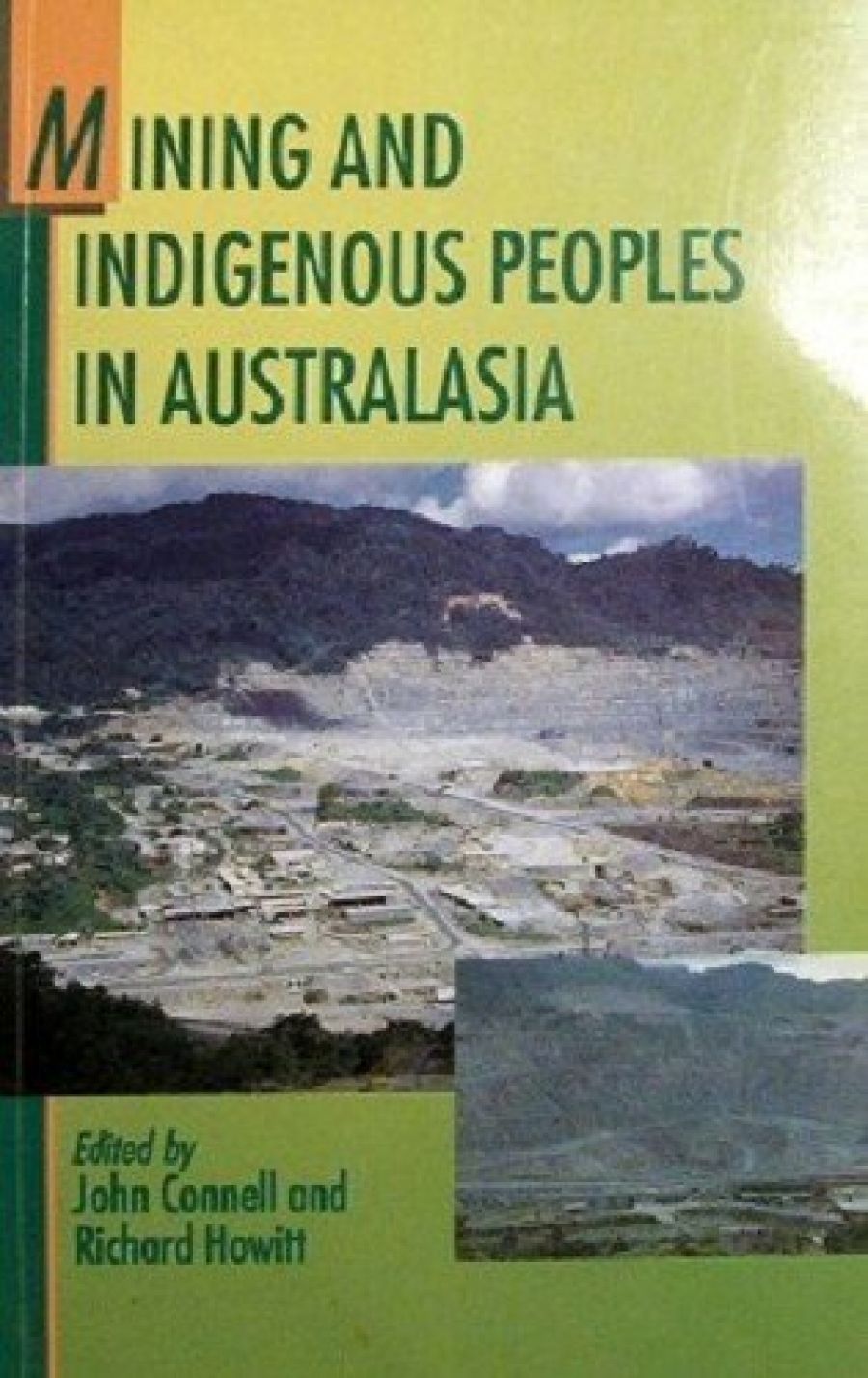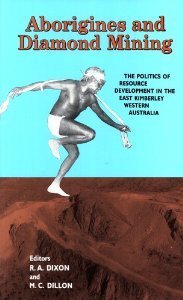
- Free Article: No
- Contents Category: Indigenous Studies
- Review Article: Yes
- Article Title: Mining and rights
- Online Only: No
- Custom Highlight Text:
If John Hewson leads the next Australian government, we are likely to see a reversal of the current government ban on mining at Coronation Hill and the lifting of other impediments to mining. Should the fight to preserve an indigenous right to negotiate other’s access to mineralised lands have to be renewed, these two books will make invaluable background reading. They document the awesome political responsibilities on nation-states wishing to encourage economic development but trying also to satisfy the legitimate and changing claims of the traditional owners of mineralised lands. National leader’s political commitment to indigenous rights is only one of the issues highlighted here. Of equal importance is the complex and changing attitudes of the landowners themselves.
- Book 1 Title: Mining and Indigenous Peoples in Australasia
- Book 1 Biblio: Sydney UP, $22.95pb
- Book 2 Title: Aborigines and Diamond Mining
- Book 2 Subtitle: The politics of resource development in the East Kimberley Western Australia
- Book 2 Biblio: UWA Press, $25pb
- Book 2 Cover (800 x 1200):

Bougainville is the outstanding example of these difficulties. John Connell chronicles its inception (1972) and its closure, in 1989, because of local’ attacks on equipment and staff. Successive attempts to placate landowners’ rising discontent through more services and payments failed because of ‘dilatory’ company performance, because of the withdrawal of politicians from any mediating role and because landowners ultimately realised that some losses were beyond compensation. In any case, as Connell reminds us, such largesse as the mine offered would cease, soon, with the exhaustion of the copper deposit.
The shadow of Bougainville falls on two other PNG projects examined here: Ok Tedi (David Hyndman) and Misima (Rolf Gerritsen and Martha Macintyre). Gerritsen and Macintyre put forward an economic model of the life-course of a mining project. This model, plotting the typical rhythms of investment, revenue, and tax/royalty flows over thirty years, predicts the typical political tensions that will arise between national and provincial governments and locals. They point to the incongruity between the presumed fixity of legal agreements and the rapid learning process to which local landowners are necessarily subject. They add that, in efforts to secure such agreements politically, national and provincial governments are forced to relate most issues of regional service and infrastructure development to the survival of the mine. The new political framework of the nation state, a fragile enough innovation at best, is thus placed under extraordinary stress by the dynamics of large-scale mining projects.
Hyndman’s chapter documents stress of another kind: environmental destruction of the Fly River. There the political translation of popular discontent at the wrecking of a natural resource is to demand more compensation and more say for provincial governments over mine-related public revenues. He also sketches two contrasting cultural responses to Ok Tedi’s ecological and economic changes: a ‘modernising’ Christian revivalism and the intensification of the traditional male cult.
Both ‘offer some prospects of increased self-determination’, he suggests, but the reader is left wondering about their contribution to the inescapably political aspects of ‘self-determination.’
‘Self-determination’ is, in any case, a term whose practical definition is politically contentious. In Fiji, as Nii K Plange shows, the unresolved tensions between multi-national goldmining and landowners of the Tavua area are implicated in the struggle, between the Labour Party and Fijian irredentists, to define and to placate landowners’ interests, and to uphold or to reconstruct the Native Land Trust Board.
The people of Soroako (a village of South Sulawesi) have found their land rights denied by the newly-sovereign nation of Indonesia, once it had militarily ensured its control over that island in the 1960s. Nickel deposits have now attracted Indonesia’s largest mine, and locals, according to Kathryn Robinson, are forced to be dependent on its fluctuating demands for labour. The Soroakans are pleased to embrace the mine offer of modernity and have markedly altered their fertility in obedience to government and company pressure, but they resent being given a second place in the benefits that development rings.
The Maori experience is covered in chapters by Kimberley Barclay-Kerr and Jennifer Dixon. Dixon traces the history of gold and (later) coal extraction on the Coromandel Peninsula since 1851. Though this region’s Hauraki Maoris were party to land sales, subsequent generations have questioned the extent to which traditional owners lost control through such nineteenth-century deals. As well, Maori environmental concerns have grown. By contrast, the Tainui people of the Waikato region lost control of their coal-rich land through warfare, in the 1860s, rather than through sales. As Barclay-Kerr shows, despite the monetary compensation paid them since 1946, they too have become dissatisfied with their land-alienated condition.
Reconsideration of the implications of the Treaty of Waitangi, since 1975, offers different opportunities for recovery to these two groups. The Waitangi Tribunal gives Maoris redress against the Crown, but not against private land-owners. The Hauraki Maoris, facing a renewal of private mining interests in the Coromandel in the 1970s, have had to work within other planning and natural resource legislation in which Maori, conservation, and mining interests are adjudicated project by project, not subject to Tribunal claims and decisions.
The New Zealand government has recently encouraged privatisation of public assets, thus threatening the scope of the Tribunal’s work. When the State Coal Mines were corporatised and began to sell off miners’ houses and mining licences in the Waikato region, the Tainui (many of them employed as coal miners) saw a threat to their pending Tribunal hearing. In 1989, a court found in favour of the Tainui: the new Coal Corporation could not pre-empt the Tribunal’s hearing of the Tainui grievance. Barclay-Kerr sees this as a land-mark decision in favour of Maori land rights.
Australian Aborigines’ involvements in mining are dealt with by Howitt (Tanami desert, gold), Robert Levitus (Arnhem Land, uranium), and Mike Dillon (the Kimberley, diamonds); Dillon’s chapter distils much of the work of the book he has edited with Rod Dixon. Howitt’s Warlpiri and Levitus’ Gagudju are both protected by the Aboriginal Land Rights (Northern Territory) Act (1977). ‘The direct and indirect impacts of mining are addressed in ways that give priority to Warlpiri self-determination,’ Howitt assures us. However, digging up the country and poisoning parts of it with cyanide causes some disquiet, and, though the Warlpiri are generally not attracted to mine employment, the cash-based economy (social security payments and royalties) creates some problems ‘particularly for women’, through excessive alcohol consumption. Reacting to corporate and political challenges (especially the anti-land rights tactics of the Northern Territory government) has disabled strategic planning for the mine’s aftermath.
Leviticus is more ethnographically informed about the Gagudju than Howitt is about the Warlpiri, and can therefore focus on an issue Howitt deals with rather allusively: the criteria of entitlement to mining’s royalties. Acknowledging Aboriginal rights to such payments creates the need to translate indigenous notions of mutual obligation and shared responsibility for land into some code decreeing who gets money and who doesn’t. This has proved to be one of the hardest tasks facing the Northern and Central Land Councils, with the potential to undermine their legitimacy in Aboriginal eyes (to the undoubted delight of the Northern Territory government). Creating royalty-receiving and distributing corporations has been the answer. Levitus’s case study of the Gagudju Association makes him the only author unequivocally to uphold the nation-state’s right to impose certain constraints, in the interests of ‘equity’, ‘legal soundness’, and ‘administrative practicality’, on the formation of an indigenous political unit.
His argument therefore takes on a challenge posed by any mining development which intrudes on the domain of kin-based societies such as those studied in these books: how to fashion viable political formations through which indigenous people might have a hope of securing their rights and of distributing whatever benefits flow from mining’s presence.
Dixon and Dillon (and their contributors) give us an exemplary instance of the difficulty of contriving representative Aboriginal organisations. As they point out, the political climate in Western Australia has not favoured recognition of Aboriginal rights; both Liberal and Labor governments have eagerly aligned themselves with the Argyle Joint Venturers, and the Western Australian Museum declined to use its Heritage Act powers to advocate the locals’ case. In that context, was it not then reasonable for a small group of traditional owners to agree, in 1980, to forswear future opposition in return for certain payments and support of their nearby outstation? Or was this betrayal?
The great value of Aborigines and Diamond Mining is that it documents not only the legal and political context of this controversial gambit, but records the varying evaluations of the agreement by Aborigines themselves, beneficiaries and others. The complexity of these Aborigines’ assessments emerges unmediated by any non-Aboriginal assumption about the nature of the ‘indigenous interest’.
The ideology of ‘development’ may push some of us into having to defend, as a profound and necessary moral abstraction, the notion of ‘indigenous sovereignty’. That the exercise of that sovereignty is as difficult as its achievement is one of the lessons of these fascinating books.


Comments powered by CComment